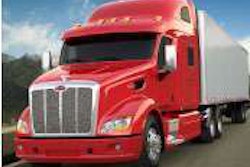A country cruise with Cummins

When it comes to road-testing a heavy-duty diesel engine, you can do a lot worse than running up and down the highways of northern Kentucky. The countryside is beautiful, and there are plenty of long gentle grades to test engine response. Even better, there are no exceptionally steep grades to worry about when ascending or descending – which is nice because brake fade is no fun to write about, let alone experience firsthand.
When the folks at Cummins asked me if I’d like to spend a morning test-driving a Peterbilt Model 387 equipped with a 15-liter 2010-compliant Cummins ISX diesel engine, I jumped at the chance. Running trucks around a test track is not a bad way to get an idea of how they perform, but nothing compares to real-world driving conditions.
Cummins created huge headlines in the summer of 2008 when it announced it was abandoning heavy exhaust gas recirculation technology in favor of selective catalytic reduction to meet tough 2010 emissions regulations. After limited production in 2009 of engines designed to meet U.S. Environmental Protection Agency requirements for 2010, Cummins began full production of EPA 2010 engines in January and has produced more than 2,500 EPA-certified 2010 engines at manufacturing facilities in Jamestown, N.Y., and Rocky Mount, N.C. Full production followed extensive testing for performance and reliability.
Lou Wenzler, director of on-highway marketing communications for Cummins, was confident that once I got behind the wheel of the Peterbilt, I’d see that not a whole lot has changed in 2010 from the driver’s point of view. As we sat waiting for the Peterbilt’s engine to warm up, Wenzler told me there was “absolutely no doubt” that Cummins had made the right decision in going with SCR. “We were researching both technologies to determine which approach was the right one for our customers,” he explains. “And as you’ll see, we’ve been able to meet the new regulations with minimal impact on our pre-existing engine technology. Any new burden on drivers and technicians is minimal, and – best of all – we actually were able to take advantage of SCR and improve engine performance and fuel economy at the same time.”
It was apparent right away that Wenzler wasn’t kidding. Our test-platform Pete was pulling a loaded 53-foot dry van, but the 500-hp ISX got us under way quickly and smoothly. Throttle response was immediate and impressive, both at low speeds and later cruising down the highway. Shift points essentially are the same as they were on pre-2010 engines. Downshifting was no problem, either, but as we drove up and down hilly Interstate 265 outside of Louisville, I discovered to my delight that there were few instances when I actually had to do so. The ISX is so well-tuned that unless you’re running through some serious hills, it’s almost like driving a truck equipped with an automatic transmission instead of an 18-speed Eaton because of the ample power going uphill and the fully-integrated Cummins engine brake going downhill. The engine is remarkably quiet, too, and I was able to chat easily with Wenzler and CCJ Senior Associate Editor John Baxter as we cruised down the highway.
In this case, no news is good news.
As our road trip wound down, I concluded that Wenzler’s initial prediction was correct: The news from the Cummins test drive was that – in many ways – there was no news; the ISX engine performed as advertised. If they had given me two trucks to drive that morning – one with a 2007 ISX and the other with a 2010 engine – I doubt I would have been able to tell them apart based on driving experience alone. All told, it was proof that Cummins has been able to deliver the goods with its 2010 diesel engine family in terms of power, performance and fuel economy. n
JACK ROBERTS is Executive Editor, Trucking of Commercial Carrier Journal. E-mail [email protected] or call (205) 248-1358.












